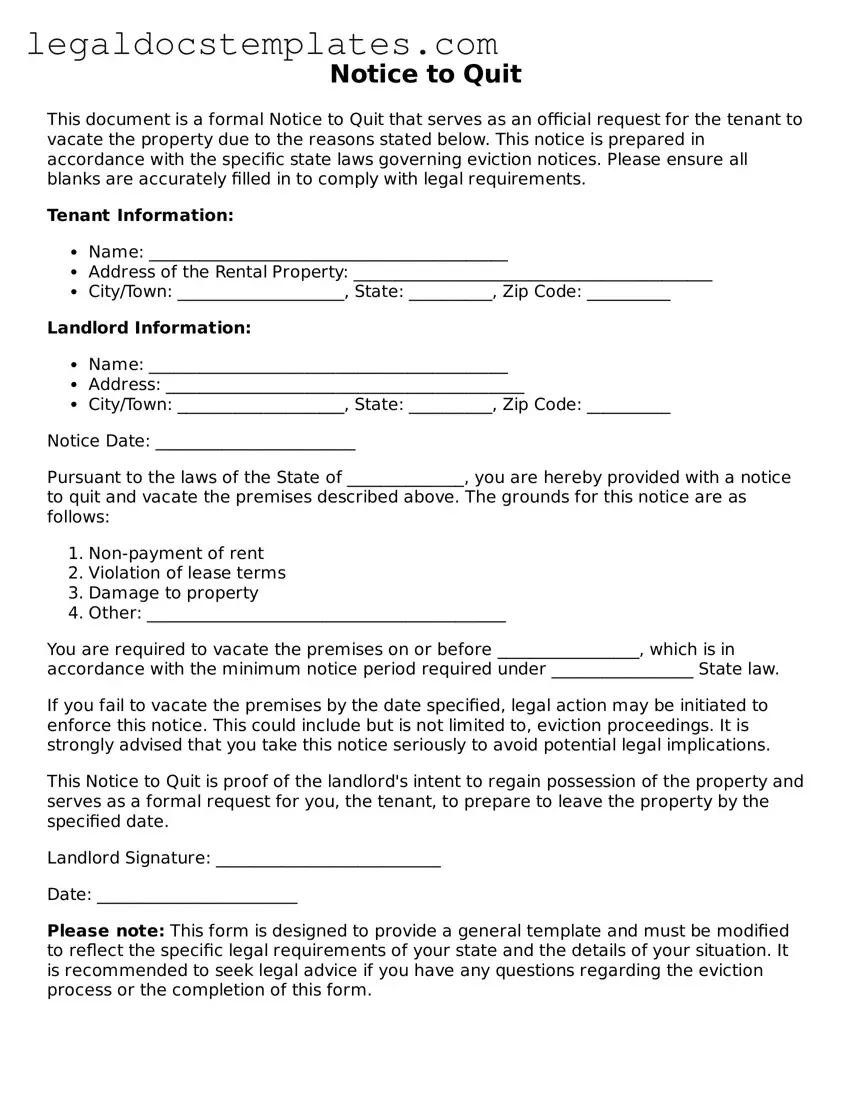The Notice to Quit form is closely related to the Eviction Notice, as both serve as preliminary steps in the process of legally removing a tenant from a property. The key difference lies in their specific function and timing; while the Notice to Quit is generally the first notice given to inform tenants of the breach of lease terms and the need to vacate, an Eviction Notice is often a more formal step that follows if the situation does not get resolved, specifying legal actions intended to enforce the eviction.
Similarly, the Lease Termination Letter shares a common purpose with the Notice to Quit by aiming to end a rental agreement; however, it differs primarily in its use between landlords and tenants. A Lease Termination Letter can be initiated by either party seeking to end the lease under terms allowed within their agreement or under mutual agreement, contrasting with the Notice to Quit which is typically landlord-initiated due to a violation or issue.
The Rent Increase Notice, while serving a different function, parallels the Notice to Quit in its procedure and legal implications. It notifies tenants of changes to the rental agreement, specifically in terms of rent adjustments. Both documents are formal methods of communication that must adhere to respective state laws and rental agreement terms, aiming for transparency and official record between landlords and tenants.
The Cure or Quit Notice is a variant of the Notice to Quit that specifically allows tenants a chance to "cure" the violation (e.g., by paying overdue rent) within a specified timeframe to avoid eviction. This document underscores the possibility of remediation, blending the imperative nature of the Notice to Quit with an opportunity for rectification.
The Pay or Quit Notice is another specialized form of the Notice to Quit, focusing exclusively on the non-payment of rent as the violation necessitating the notice. It requires the tenant to pay the overdue rent by a certain date or vacate the premises. This document underscores the seriousness of fulfilling financial obligations under the rental agreement.
Unconditional Quit Notices demand the tenant to vacate without offering an opportunity to remedy the violation, making it the most severe type of quit notice. It is used in extreme situations, such as repeated violations, significant damage to the property, or illegal activity. This document shares the purpose of property protection with the Notice to Quit but operates under a stricter, less forgiving framework.
The 30-Day Notice to Vacate serves as a common timeframe for tenants to prepare to leave the property, often used in conjunction with the Notice to Quit for non-renewal situations or end of lease term scenarios. It provides a clear, structured timeframe for vacating, aligning with many state laws on tenant notice periods. While it can be a standalone document, it often complements the Notice to Quit in ensuring both parties have adequate time to make necessary arrangements.
The Property Management Agreement outlines the responsibilities and expectations between property owners and managers, including how notices, like the Notice to Quit, should be handled and delivered. While it is more comprehensive, covering various aspects of property management, the sections regarding tenant management and legal notices intersect with the objectives of the Notice to Quit in ensuring lease compliance and property preservation.
Lastly, the Tenant's Notice of Intent to Vacate mirrors the Notice to Quit in reverse, with the tenant initiating the notice to the landlord, informing them of the intent to leave the property by a certain date. This document, often a precursor to the formal ending of a rental agreement, mitigates surprises and gives landlords time to prepare for re-renting the property, thereby maintaining a smooth transition similar to the rational objectives behind the Notice to Quit.
